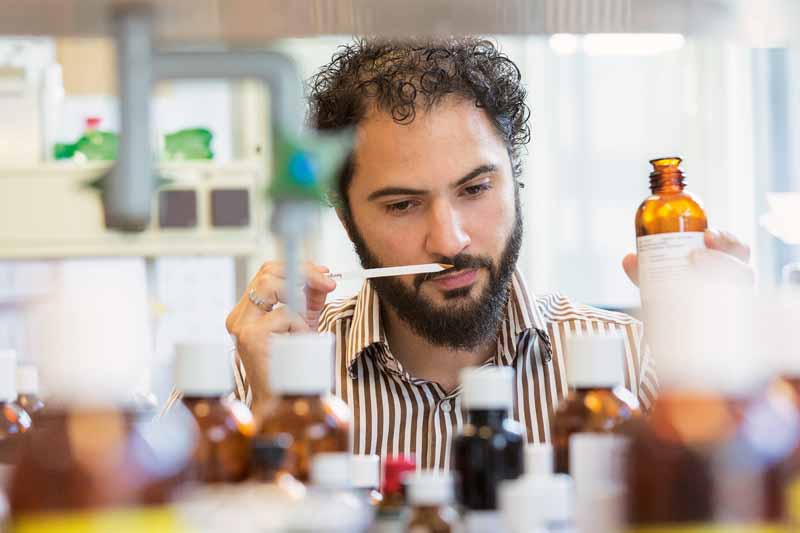Who’s who among supplies of tobacco and vapor flavorings
TR Staff Report
Tobacco and e-liquid companies use flavorings to produce consistent, high-quality products and set their brands apart from the competition. In today’s heavily regulated tobacco manufacturing environment characterized by a dwindling number of approved ingredients, superior skills and know-how are in high demand. The professional flavorings supplier must be highly experienced not only in new technologies and smoke chemistry but also in patent protection and other legal issues. And because flavorings are keys to brand identity, the importance of confidentiality cannot be exaggerated.
Alternative Ingredients
Established in 2014, Alternative Ingredients is fully dedicated to next-generation products and electronic nicotine-delivery systems. the company has a state-of-the-art creation center and an ISO 7 production clean room. Alternative Ingredients develops special flavors designed for next-generation products and electronic nicotine-delivery systems. It offers customized finished e-liquids and a variety of nicotine solutions.
Borgwaldt Flavor
Borgwaldt Flavor, part of Hauni Maschinenbau, develops and produces flavors and casings for cigarettes, pipe tobacco, cigars, water pipe tobacco, RYO/MYO, chewing tobacco, moist snuff, kreteks, heated-tobacco products and filter capsules as well as flavors and liquids for e-cigarettes. Borgwaldt Flavor also offers tobacco additives such as anti-mold agents, burn additives and humectants as well as insect control and monitoring material. Borgwaldt Flavor works in close collaboration with customers by offering consulting services in product development, blending, processing and manufacturing technology.
Curt Georgi
Founded in Germany in 1875, Curt Georgi is a traditional flavor and fragrance house—and still family-owned. Located in Boblingen, Germany, the company has more than 11,000 square meters of production facilities. With subsidiaries in many countries and professional partners around the world, Curt Georgi is able to offer its products globally. Curt Georgi offers flavors for cigarettes, cigars, shisha and other products as well as a complete service package, including professional, free consulting on all aspects of tobacco product manufacturing. The product range consists of burley casing, flue-cured casing, stem casing, Virginia casing, top flavors, full-blend casing (for blended, Virginia and kretek cigarettes) and irritation “improvers” in ready-to-use or concentrated varieties. The company also specializes in flavors for water pipe tobacco, pipe tobacco, cigars, snuff and chewing tobacco.
Hertz & Selck
Hertz & Selck develops and produces high-class flavors for the international tobacco industry. Its wide-ranging portfolio covers flavors from classic natural extracts through exclusive top flavors to the latest fashionable flavors. Applications comprise cigarettes, cigarillos and cigars, rolling tobacco, pipe tobacco, chewing tobacco, snuff and water pipe tobacco, filters, cigarette papers and e-liquids plus regional products such as khaini, kreteks, bidis and snus. With its focus on tobacco industry products, a network of distribution partners and representatives on four continents, Hertz & Selck is well established today. Thanks to its extensive experience on the international market and its familiarity with the requirements of end consumers, Hertz & Selck supports its customers throughout all phases of product development, from the initial idea to market launch. Hertz & Selck aims for excellent quality in all areas of activity. The company attributes its success to its passion for tobacco, which has shaped Hertz & Selck for more than 80 years.
Hertz Flavors
Dedicated to the tobacco industry, Hertz Flavors has established itself as Europe’s leading supplier for unique flavors of premium quality made in Hamburg, Germany. The company’s philosophy is simple: to provide tailor-made solutions for superior taste. Together with its customers, Hertz Flavors creates flavors for tobacco products with character, including top flavors, casings or other tobacco additives for cigarettes, shisha, kretek, RYO/MYO, heat-not-burn, cigars/cigarillos, pipe, snus/snuff, capsules/filter, e-liquids or any other innovative product category.
Mane Flavors
Headquartered in Vouvry, Switzerland, Mane’s tobacco business unit offers the following products to the tobacco industry: top flavors, top casings and casings, natural extracts, essential oils, absolutes, menthol, microencapsulated flavor systems for capsule/molecular encapsulates, development, consulting and tobacco blend formulation. Worldwide, the company has 21 production facilities, and its tobacco business unit has five tobacco flavor development units. Most recently, e-liquids and reduced-risk product applications have been at the forefront of new Mane technology developments. The tobacco business unit has secured a global network of partnerships to ensure a seamless development and supply line for e-flavors and e-liquids, guaranteeing the current and future regulatory compliance of products while also ensuring the traceability of all raw materials.
Mother Murphy’s Laboratories
Founded in 1946, Mother Murphy’s Laboratories is a privately owned flavor manufacturer located in Greensboro, North Carolina, USA. the company began working closely with the tobacco industry in the late 1980s and is currently selling tobacco flavors in more than 15 countries. Its offerings include complete casings, flavor for casings, top dressings, top flavors and functional ingredients—all designed and tested for applications like cigarettes, cigars, water pipes, smokeless tobacco products, filters, etc.
Taiga International
Offering more than just flavoring, Taiga International’s services range from tobacco selection to blend development and cigarette design. Based in Breendonk, Belgium, Taiga International’s products include flavors, casings, enhancers and other ingredients for cigarettes, cigarillos, kreteks, shisha, pipe tobacco, RYO/MYO, snuff and snus. The company also offers flavors for e-cigarettes, e-liquids and e-hookahs. To mimic the smoking sensation of a traditional cigarette as closely as possible, Taiga International has developed a special series of e-liquid flavors. Different varieties are available, from traditional or brand-type cigarette flavors to food flavors. These flavors include blended-type top flavors, burley flavor, chocolate, menthol and Virginia top flavor types.
Tobacco Technology Inc.
Founded in 1975 in Maryland, USA, Tobacco Technology Inc. (TTI) develops customized flavors for smoking products, including casings, cigarettes, water pipes, snuff, snus, chew, kreteks, RYO, pipe tobaccos, hemp and dissolvables. TTI also offers consulting services to facilitate flavor, process and product development. TTI subsidiary E-LiquiTech is dedicated to e-liquids, bottling and cartomizer filling. TTI Flavors s.r.l. will open in Assisi, Italy, in 2020 and is a manufacturing facility for flavors, casings and e-liquids, bringing faster delivery to customers in the Middle East, Europe, Africa and Russia.







































